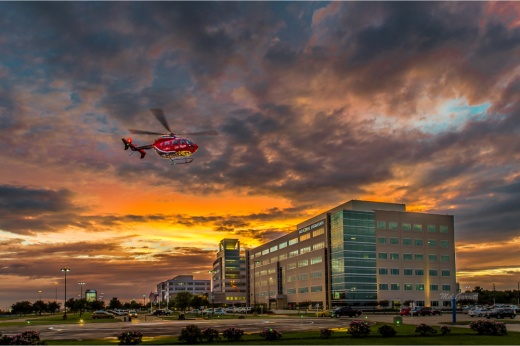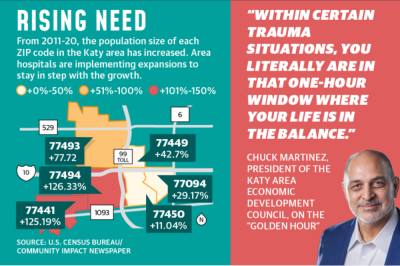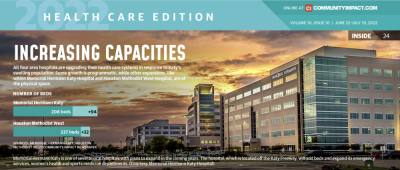All four major Katy-area hospitals are working on projects to expand their facilities and services to match the growing population. Projects are in varying stages of development.
1. Memorial Hermann Katy Hospital will add a new office building; overhaul the women’s services department; and expand the emergency services department, Breast Care Center and Ironman Sports Medicine Institute.
- Number of new beds: 94
- Cost: $167 million
- Timeline: March 2022-fall 2024
- Number of new beds: TBD
- Cost: TBD
- Timeline: spring 2023-TBD
- Number of new beds: 32
- Cost: $87 million
- Timeline: spring 2022-fall 2023
- Number of new beds: 22
- Cost: TBD
- Timeline: June 2022-TBD
Rising Need
From 2011-20, the population size of each ZIP code in the Katy area has increased. Area hospitals are implementing expansions to stay in step with the growth.
- 77493, +77.72%
- 77494, +126.33%
- 77441, +125.19%
- 77450, +11.04%
- 77094, +29.17%
- 77449, 42.7%
Between 2011-20, the six ZIP codes that make up Community Impact Newspaper’s coverage area—77449, 77493, 77494, 77441, 77450 and 77094—saw a 57.31% population increase, from 246,673 to 388,036, according to U.S. Census Bureau data. The Katy Area Economic Development Council expects the area to gain 31,185 more residents by 2025.
As the area’s population steadily rises, Memorial Hermann Katy Hospital, Houston Methodist West Hospital, Texas Children’s Hospital West Campus and MD Anderson West Houston will spend at least $254 million to grow their facilities and services over the next five years. Projects include a trauma center expansion, new medical office buildings, and renovated sports health and women’s health centers.
Jerry Ashworth, CEO of Memorial Hermann Katy as well as the Cypress campus, said the goal for these hospitals is to provide a level of care and access that rivals the Texas Medical Center. Memorial Hermann Katy and other hospitals use their relationship with Katy ISD, the Katy Area EDC and strategic planners to better understand where there are health care gaps, he said.
“People that live in Katy want to receive their care in Katy,” Ashworth said. “They do not want to go somewhere else. ... So that’s what we are trying to build and create.”
Katy Area EDC President Chuck Martinez agreed that area hospitals are evolving to address inequities in service compared to the TMC.
“It’s an interesting dimension, in terms of cost and quality, that even the health care industry is trying to resolve the gaps within their own profession,” Martinez said. “Just because you live in an underserved area does not mean that you should be deprived of that quality of care.”
Mirroring the Texas Medical Center
The four major hospitals in the Katy area all have plans to provide greater capacities for care in the area that are in step with the TMC, according to hospital executives.
Matt Timmons, Texas Children’s West Campus vice president, said the hospital will fill almost 6,000 square feet of unused space within the existing campus over the next two years. Additionally, construction began in June on a parking garage to precede a new medical office, the cost of which has not yet been determined.
Similarly, MD Anderson West Houston is adding technology to mirror its TMC campus, including MRI, CT scanners and additional tools for radiology diagnostics as well as capabilities for anesthesia and endoscopy.
“We are reducing the need for people to have to travel large distances,” said Kent Postma, vice president of the west Houston campus. “As the population grows west and the infrastructure grows, we’ve been able to move out with it.”
Additionally, Houston Methodist West Hospital is instituting several projects that total over $87 million and will span the next five years as part of its master plan, according to Chief Operating Officer Kyle Stanzel.
The hospital broke ground on a $65 million, six-story medical office building in May that is set to open by the end of 2023, Stanzel said. This will be the campus’ third medical office, providing services in physical therapy, orthopedics and sports medicine.
Meanwhile, Memorial Hermann Katy began its $167 million expansion project in March that will focus on expanding the emergency services department, with subsequent phases bringing additions to the women’s health department and its sports medicine sector, Ashworth said. Memorial Hermann Katy is the exclusive provider for KISD’s athletic training program, according to Ashworth. As far as emergency services, this department must grow in tandem with the population, Ashworth said.
Trauma care
Memorial Hermann Katy is designated by the Texas Department of State Health Services as a Level III trauma center. It is the only Level III trauma center in the Katy area, Ashworth said.
“We are seeing a significant increase in our trauma volumes,” he said.
As a Level III trauma center, Memorial Hermann Katy is expected to provide 24-hour care by emergency physicians; the prompt availability of general surgeons and anesthesiologists; and backup care for other rural and community hospitals, according to the American Trauma Society.
With its expansion project, the hospital plans to double the size of its emergency services department to 40,000 square feet and add treatment rooms, CT scanners and other upgraded equipment as well as capabilities for trauma and critical care medicine, neurosurgery, vascular surgery and thoracic surgery, Ashworth said.
The time frame in which emergency services have to deliver life-saving treatment that will stabilize a patient is vital. Health care professionals refer to this time frame as the “golden hour,” Martinez said.
“Within certain trauma situations, you literally are in that one-hour window where your life is in the balance,” he said.
To that end, Brian Petrilla, Fort Bend County deputy chief of emergency medical services, identified the lack of Level I trauma centers—the highest designation—in the area as a significant health care gap. Petrilla said a growing population inevitably puts strain on emergency services.
“We are starting to see that we need more ambulances in the [Katy] area,” he said. “A growing population also means more traffic, which makes it harder for us to get places.”
Growth-related challenges
Aside from accessibility and trauma care, other challenges the health care industry is facing when adapting to fit a growing population include staffing shortages and supply chain issues.
Petrilla said EMS has been impacted by supply chain hurdles.
“[Medications] are on backorder or they aren’t making them anymore,” he said. “It takes a long time to get stuff repaired [and] to buy new stuff. It’s probably the No. 1 stressor on EMS.”
An issue for all four area hospitals is staffing and retention. Based on data from the Texas Health and Human Services Commission, the demand for all physicians is expected to worsen on a statewide scale, with a deficit of 6,218 physicians in 2018 projected to grow to 10,330 physicians in 2032.
In the Gulf Coast Region—which includes Katy—family medicine, pediatrics, general internal medicine, nephrology and psychiatry are specialties set to have the most shortages.
“We need to be able to keep up with our employee pool—whether it’s increasing our talent base or if we need to educate and attract skilled health care providers,” Postma said.
Memorial Hermann Katy has a strategy to develop these partnerships at the high school level to streamline a workforce pipeline into Katy’s health care industry.
“One of the things we are doing is partnering with various educational organizations to create more of a pipeline for individuals that grew up in Katy, want to live in Katy and want to work in Katy,” Ashworth said. “That pipeline starts with Katy ISD.”
KISD’s Miller Career & Technology Center has a Clinical Rotation and EMT Basic Program. For the 2022-23 academic year, participating students will partner with Memorial Hermann Katy to continue clinical rotations, said Maria DiPetta, KISD’s media relations and multimedia manager.
Houston Methodist West Hospital has a similar strategy to counter staff shortages, in which it uses its resources in education to strengthen the workforce pipeline.
Stanzel said the hospital’s chief nursing officer is an adviser to The University of Houston’s nursing program, and they often talk about how this relationship could be beneficial.
“[UH is] having active conversations [to determine]: How do we take a retired nurse and get them into teaching so they don’t get out of the field altogether?” he said. “It’s also programmatic: How do we build additional programs and open up additional seats?”







